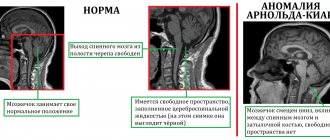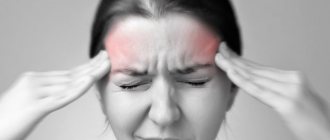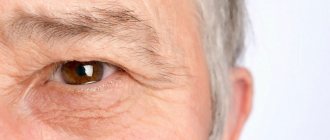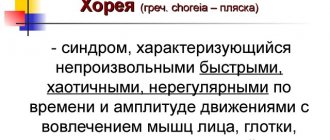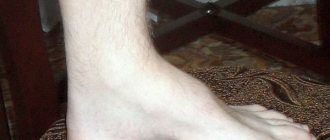Medical characteristics of hysteria
Hysteria is a mental disorder that manifests itself in various vegetative and affective deviations from the norm. Changes in behavior are dictated by the patient’s desire to attract the attention of others by any means.
The term “hysteria” is no longer used in psychology. Initially, hysteria was understood as a specific disease; today this term combines several forms of deviations:
- histrionic personality disorder (HPD);
- conversion violations;
- anxious hysteria, etc.
Symptoms
Patients experience strong mood swings - from elation to depression and despair. Patients are egocentric, suggestible, and always want to be the center of attention of others. They are distinguished by eccentric behavior and unusual appearance. The development of the disease entails changes in a person’s physical well-being. Restless patients are diagnosed with a number of sensory, motor and somatic disorders.
Histrionic personality disorder (HPD) is characterized by the manifestation of a number of behavioral characteristics:
- increased emotionality;
- theatricality of actions;
- the desire to be the object of everyone's attention;
- excessive sociability;
- anxiety about one's own attractiveness;
- desire to manipulate people;
- inability to objectively evaluate one's own actions.
In more severe forms of the disease, patients experience severe symptoms such as loss of sensation in areas of the body, paralysis, tremors of the limbs, blindness or muteness. A change in consciousness occurs, and amnesia becomes a frequent accompaniment of hysterical disorders.
Hysterical attack
An acute form of mental illness is a hysterical attack. A sudden attack is characterized by a violent manifestation of emotions: a violent patient hits his head, screams, cries, tears his hair and clothes, and bends over.
An attack can be triggered by an unusual situation - bad news, an unpleasant event, a quarrel, failure to comply with the patient’s whims.
Before an attack, a person complains that he feels dizzy or has dark vision. However, the cause of the seizure is not physiological processes.
It is usually staged and completely controlled. From the outside, a hysterical attack is similar to an epileptic attack, but:
- the hysterical person remains conscious, he knows how to fall “correctly” so as not to get injured;
- the patient controls physiological processes, does not allow involuntary urination, defecation and other situations accompanying an epileptic seizure.
The purpose of a hysterical attack is to gain attention. If there is no expected reaction from the public, the seizure ends and the person calms down.
Stopping a seizure is not difficult. The person will be brought to consciousness:
- loud voice;
- cold water;
- physical impact.
The theatricalization of attacks is caused by the appearance of vivid hallucinations that replace reality. In psychiatry, this condition is called the hysterical twilight state. It can be short-term or last a long time.
In severe cases, the patient is unable to answer simple questions or solve a simple mathematical equation. The person is disoriented in space, indifferent to what is happening around him. This condition is called Ganser syndrome.
After the end of the seizure, the patient, as a rule, experiences temporary amnesia; he cannot remember the events that happened to him.
Diagnosis and treatment of hysteria
Patients with hysterical disorders like to imitate various diseases. By demonstrating their painful condition to others, they themselves eventually begin to believe in fictitious diseases. This feature helps diagnose hysteria. A medical examination reveals the inconsistency of the patient’s complaints. Consultation with a psychiatrist is necessary for a correct diagnosis.
The treatment of hysteria consists in correcting the patient’s psyche. The psychotherapist, using suggestion, helps the patient learn to perceive himself and the world around him.
Occupational therapy helps combat the manifestations of hysteria.
Drug treatment involves the use of drugs based on medicinal herbs (valerian, motherwort) to reduce excitability.
Psychiatry Mental disorders in general medicine No. 03 2007
“Skin neurosis” (21 observations) is manifested by neurotic excoriations - compulsive repeated actions (scratching healthy skin) aimed at getting rid of primary painful sensations projected onto the skin (painful, unbearable burning, feeling of bursting or pricking from the inside, biting, crawling “pins and needles” under the skin, subjectively defined as “itching”) [20]. Self-harm was most often inflicted with nails, less often with tweezers, and sometimes cauterizing, irritating liquids (iodine, an alcohol solution of brilliant green, a concentrated solution of potassium permanganate) were additionally used. The generalization of auto-aggressive behavior was accompanied by an irresistible craving for the “mechanical” removal of all detected “irregularities” on the skin, which implied the excoriation of both areas of healthy skin and the extraction of pre-existing abrasions and the crusts covering them, forming areas of scar tissue. Involutionary hysteria
with comorbid somatic (cardiovascular or endocrine) pathology. Cardiovascular diseases are represented in the studied sample by arterial hypertension, identified during physical and instrumental examination in 23 patients, heart rhythm disturbances - in 7 and angina pectoris - in 5 (a total of 36.5% of the total number of patients). The main characteristics (including the average duration) of somatic pathology and comorbid involutional hysteria are presented in the table. Moving on to a discussion of these data, it is important to emphasize that the debut or exacerbation of cardiovascular disorders in all studied cases were associated with the influence of psychotraumatic factors (psychogenic provocation of paroxysms of atrial fibrillation or monomorphic ventricular extrasystoles, or hypertensive crises; emotiogenic attacks of angina. The severity of the identified somatic pathology turned out to be moderate, as evidenced primarily by infrequent hypertensive crises and heart rhythm disturbances (on average 4.3 ± 0.9 times per month), which were self-limited with antihypertensive or antiarrhythmic drugs, as well as attacks of angina pectoris (7.1 ± 0.7 times a month), which are reduced after the use of nitrates. In addition, no complications of arterial hypertension such as cerebrovascular accidents, dyscirculatory encephalopathy, renal and heart failure were identified. With angina, typical cardiac attacks of moderate tension (FC II) were observed without such complications as heart failure. Heart rhythm disturbances were limited to signs of first degree atrioventricular block, disturbances of local and/or general contractility or LV diastolic dysfunction (ejection fraction - 65.0±6.6%). The moderate severity of somatic pathology is confirmed by the results of EchoCG, according to which in most cases (21 out of 23 observations) no signs of LV myocardial hypertrophy were found (the thickness of the interventricular septum and the posterior wall of the LV was 0.99 ± 0.13 and 1.01 ± 0.11 cm respectively), as well as treadmill test data indicating average and high tolerance to physical activity (18 out of 23 observations) and, accordingly, high compensatory capabilities. All of the listed clinical features of cardiovascular pathology indicate a relatively favorable course of somatic disease in patients with involutional hysteria. Endocrine disorders were identified in the majority of patients (64 observations - 66.7% of the total) and were expressed by menstrual cycle disorders (decreased estrogen levels), sexual dysfunction, increased or decreased libido, and unpleasant sensations in the genital area during intimate contact. Climacteric syndrome (N95.1 according to ICD-10) was expressed by neuroendocrine manifestations (weight gain, hot flashes to the upper half of the body, late menopausal disorders with trophic metabolic disorders in the form of dry mucous membranes, osteoporosis), noted in other works (M.L. .Krymskaya, 1989).
Conclusion
The study allows us to expand the traditional understanding of involutionary hysteria and determine the psychosomatic relationships that develop between somatic illness and psychopathological disorders. In the light of the data obtained, involutional hysteria can be presented as an independent psychosomatic disease: in some cases, somatic or endocrine pathology is a trigger for the formation of involutional hysteria, and in others, hysterical hypochondriacal manifestations contribute to the “trigger” of somatic and endocrine disorders. Based on the concept of involutional hysteria as a psychosomatic disease, approaches to the treatment of conditions united by this concept, including both psychotropic and somatotropic drugs, have been identified. In a psychiatric hospital, in most cases, combination therapy is carried out. In case of comorbidity of conversion and depressive disorders, along with anxiolytics (clonazepam, alprazolam, lorazepam, diazepam), antidepressants are used, both traditional (TCA - melipramine, amitriptyline) and modern (SSRIs - paroxetine, fluvoxamine, citalopram, dual-action drugs - venlafaxine, duloxetine) . When somatoform disorders dominate in involutional hysteria, small and medium doses of atypical antipsychotics that show affinity for bodily disorders (quetiapine, amisulpiride) are effective. Treatment of patients hospitalized in a psychiatric hospital and without comorbid somatic pathology is carried out in two stages. The first includes a course of intensive relief therapy, involving intravenous drip administration of drugs (polycyclic antidepressants - melipramine, amitriptyline, ludiomil up to 100 mg/day) in combination with benzodiazepines (diazepam up to 20 mg/day) or with antipsychotics (sulpiride up to 400 mg/day ). The second stage of psychopharmacotherapy - maintenance - includes oral administration of psychotropic drugs in average daily and small doses. Conducting psychopharmacotherapy in patients with involutional hysteria in a somatic hospital with concomitant cardiovascular and endocrine pathology requires caution and consideration of the possible risk of adverse side effects (cardiotoxicity of TCAs, hypotensive effects of tranquilizers and antipsychotics, etc.) and/or unwanted interactions with somatotropic drugs. For such patients, it is preferable to prescribe psychotropic drugs in minimal starting doses and gradually increase them to individually tolerated doses. Since the use of the main classes of antidepressants in a somatic hospital was limited, a special pharmacological prospective study was conducted, the purpose of which was to study the effectiveness and tolerability of the antidepressant Coaxil in patients with involutional hysteria, comorbid cardiovascular pathology. 20 patients from the general sample of the cardiology hospital received Coaxil monotherapy (daily dose 37.5 mg). The duration of the course was 6 weeks. By the end of the study, 73% of patients were responders (see figure), i.e. During Coaxil therapy, the majority of patients experienced a complete or pronounced therapeutic effect (according to the General Clinical Impression scale - the “improvement” subscale and the Hamilton Depression and Anxiety Scale). When treated with Coaxil, there was not only a reduction in psychopathological manifestations (depressive, anxiety disorders, conversion and phobic manifestations accompanying and amplifying/duplicating attacks of arterial hypertension, heart rhythm disturbances, angina pectoris), but also stabilization of the somatic condition of patients (reduction in the number of psychogenically provoked hypertensive crises ( initially 4.4±0.8 per month, by the end of the course - 0.8±0.6), paroxysms of heart rhythm disturbances (initial 6.2±1.1 per month, by the end of the course of therapy - 2.2±1 ,5), angina attacks (initially 4.3±1.2 per month, by the end of the course – 1.2±0.4). During the use of Coaxil, no undesirable interactions with somatotropic drugs were observed. The effect of antianginal drugs did not decrease, unfavorable No side effects were recorded when combining Coaxil with cardiac glycosides and diuretics.The drug did not enhance the hypotensive effect of calcium channel blockers, angiotensin-converting enzyme inhibitors and b-blockers.
Hysteria according to Z. Freud
For a long time, hysteria was diagnosed only in women. Cases of male hysteria were first recorded by the French neurologist J. Charcot, then studied by the famous psychologist Z. Freud. In his research, a description of the disease appeared for the first time.
Freud considered the cause of hysteria to be the manifestation of the subconscious, unsatisfied desires hidden in it. He believed that the prerequisites for the disease were hidden in childhood traumas and unpleasant events that influenced the development of personality during growing up. The cause of hysteria, according to Freud, is also associated with sexual complexes. Therefore, the first manifestations of hysterical disorders are observed in childhood or adolescence.
The case of Anna O.
The case history of Bertha Pappenheim, known under the pseudonym Anna O., influenced the development of psychoanalysis in the method of S. Freud.
A young intelligent girl suffered from hysteria, she had the following symptoms: impaired vision and speech, paralysis, mental disorders, memory loss.
The girl’s attending physician, Joseph Breuer, used hypnosis for treatment. Immersed in a special state, Anna recalled the events that had traumatized her. Breuer discussed these memories with Anna, and after the conversations the girl’s mental state improved. She experienced her sessions with Breuer as “cleansing” through “healing conversations.” Hypnosis and subsequent conversation freed the patient’s consciousness from thoughts and memories that tormented her, thereby weakening or completely eliminating the symptoms of the disease.
More than 9,000 people have gotten rid of their psychological problems using this technique.
Breuer did not cure Anna O.; the girl was placed in a hospital, where she received treatment traditional for those years. But the case history described by Breuer played an important role in the development of psychoanalysis.
Breuer discussed cases from his practice with S. Freud, a colleague and close friend. Having studied the history of the disease, Freud came to begin to explore the mechanism of neuroses. Breuer's practice discovered for Freud the method of therapeutic conversation with the patient and the method of catharsis. He used this in his practice, replacing hypnosis with suggestion, and then with the method of free association.
The cathartic method is used in modern practice to treat hysteria. It allows the patient to remember and relive the events that became the source of the trauma.
Symptoms and behavioral characteristics of hysterical women
Despite the “universality” of hysterical neurosis, women still suffer from it much more often. Female hysteria is often called fire, warming some men and burning others. It is different:
- special emotionality and artistic pathos;
- mood swings against the background of chronic dissatisfaction with life (uncontrollable crying is replaced by uncontrollable laughter);
- theatrical hand-wringing;
- prone to scandals;
- breaking dishes and demonstrative “attempts” at suicide (all this is no more dangerous than an ordinary performance);
- thrashing and shortness of breath;
- vegetative manifestations - pain in different parts or organs of the body, spasms, nausea, vomiting, dizziness, itching;
- false fainting and paralysis.
When women faint in a fit of hysteria, they are almost never injured because they control their fall.
Theatrical swoon
Signs of hysteria in women often resemble attacks of really dangerous diseases, such as bronchial asthma or appendicitis, but in reality there are no pathological changes in the organs that could cause such symptoms.
The patient's fantasy is so strong that she can actually become convinced of her own ill health and feel pain and lightheadedness.
Organic signs of hysteria in women quickly “dissolve” if no one pays attention to their emotional behavior or the “spectators” simply disperse. Having recovered from the attack, a woman can pretend that she doesn’t remember anything and complain about amnesia, which, however, also passes quickly, since it causes certain inconvenience to the patient.
Women suffering from hysteria can talk for hours about their “symptoms”, giving the smallest details of the ailment. It seems that they revel in their condition, and this is so, because it provides them with close attention and care from others.
Hysteria
Manifestation of hysteria in women
According to statistics, women more often suffer from hysterical disorders due to physiological and behavioral characteristics.
From a physiological point of view, the development of hysteria is influenced by hormonal changes. Minor fluctuations during the menstrual period are not dangerous; they only affect the woman’s well-being. Hormonal surges during puberty, the postpartum period and the onset of menopause often cause mental disorders, including hysterical disorders.
Behavioral characteristics are associated with a woman’s unconditional desire to arouse admiration or envy, to attract attention. In addition, women are more excitable, they are characterized by nervousness and irritability.
Psychologists associate the emergence of factors leading to the development of the disease in women with the use of incorrect psychological attitudes in childhood. Girls develop a false idea of gender inequality, the family and the role of women. Often there is suppression of sexual desires, which do not disappear, but take the form of affect.
Hormonal changes during puberty negatively affect the female psyche, exacerbating the preconditions for the occurrence of hysterical disorders.
Women with hysterical disorders are characterized by infantilism, which is manifested by a number of behavioral features:
- immaturity of judgment;
- inability to adequately perceive criticism;
- inability to critically evaluate one's own behavior;
- susceptibility to suggestion from third parties.
The peculiarity of the course of the disease in women is expressed in the variability of symptoms.
Movement disorders
During hysteria, movement disorders can be recorded, manifested by paralysis, paresis (partial loss of muscle strength), as well as contractures (limitation of passive movements in any joint) and hyperkinesis (involuntary violent movements in different muscle groups.).
Hysterical paralysis and contractures often affect a part of the body (mainly limbs) that corresponds to the generally accepted division (we are talking about an arm or leg, hand or foot). In this case, one arm or one leg is affected, both arms at once, or one arm with one leg, and on the same half of the body, all limbs can be affected at once. In turn, paralysis of the muscles of the tongue and neck is quite rare.
Hysterical contractures mainly affect the muscles of the limbs of the neck (so-called hysterical torticollis) and torso. Thus, the patient’s body can fix the body in truly elaborate poses that are unusual for organic lesions. In cases where, with true paralysis or contractures, extinction of reflexes and a significant decrease in muscle tone is observed, this is not observed during hysterical paralysis and contractures. On the contrary, all reflexes remain alive, while muscle tone is normal.
It must be said that hysterical movement disorders manifest themselves during sleep or in extreme situations. There is a known case when a woman, who was confined to a wheelchair because she was paraplegic, not only jumped up during a fire, but also managed to pull out a chest with valuables from the burning house, which two men subsequently could not budge .
Patients with hysterical movement disorders do not have the characteristic posture of truly paralyzed people: for example, their limbs simply drag, resembling tethered prostheses. Interestingly, the legs of such patients are more severely affected than the arms, since it is the arm that is involved in eating and caring for oneself. In addition, in patients with hysteria, the muscles of the face or tongue are extremely rarely affected, which is a common occurrence in paralyzed patients. And this is not surprising, because patients with hysteria will not be able to stage performances without these body parts.
Manifestation of hysteria in men
The disease is diagnosed using the same signs as in women.
Many years of experience in studying the nature of the disease in men made it possible to identify specific symptoms:
- rapid mood changes from crying to nervous laughter;
- feeling of lack of air;
- arrhythmia;
- frequent dizziness and headaches;
- “staggering” gait;
- feeling of a lump in the throat.
The causes of the disease in men are closely related to certain character traits of the patient. Increased emotionality and infantilism lead to changes in behavior. Common factors in the development of the disease in men are abuse of alcohol, narcotic and psychotropic substances. The patient’s psyche is also affected by dissatisfaction with professional activities and difficult relationships in the family.
Sensitivity disorders
In the process of hysteria, sensitivity disorders are recorded, expressed in a decrease in pain sensitivity or in its increase, not to mention hysterical pain. At the same time, the distribution of areas of the disorder does not correspond at all to the areas of supply of nerves to the sensitive nerve roots, responding only to the patient’s ideas about the distribution of functions. For this reason, complete or partial loss of sensitivity often takes the form of geometric shapes. If the patient learns about the correct areas of innervation, then the existing areas of anesthesia change.
In turn, hysterical pain may well be of a varied nature and different (sometimes simply unimaginable) localization (for example, a limited area of the head, into which it is as if a nail is being driven in). Often the pain can be localized in the place where the patient previously had some kind of injury.
It must be said that hysterical pain is extremely difficult to distinguish from physical pain. To differentiate the pain syndrome and its nature, it is necessary to give the patient an anesthetic, and so that he does not know about it. Result: psychogenic pain will remain, but physical pain will decrease. If a patient is instilled with the idea that pain is reduced as a result of taking a certain “medicine” and given colored water to drink, then this imaginary medicine will act on the patient. This is the difference between psychogenic pain and physical pain.
Uterine rabies and hysteria in the 19th century
The name of the disease comes from the ancient Greek word meaning “uterus”. For the first time, a description of hysteria appears in Hippocrates; in the writings of Plato, the disease is characterized as “rabies into which the uterus of a woman who is unable to conceive falls.” The disease received a second name - “uterine rabies”. The ancient Greeks believed that the uterus could move freely throughout a woman’s body, entering the heart, brain and other parts of the body, causing changes in behavior and consciousness, and insanity.
The manifestation of symptoms of hysteria in the Middle Ages was associated with demonism. Women could be burned at the stake, accused of being associated with “evil spirits,” and Catholic priests practiced exorcism rites to expel demons from the womb.
In Russia, the idea of women being possessed by demons was closely connected with the concept of “hype”. “Cliquers” are known for involuntarily screaming incoherent phrases during church services, and often having hysterical fits. The behavior of restless women was explained by the influence of demons that possessed them.
In the 19th century, primitive ideas about the nature of the disease gave way to common sense. But doctors continued to link the nature of the disease with the effects of the uterus. Until the beginning of the 20th century, treatment was based on the physiological effect on the disease.
Most of them were harmless and were aimed at satisfying the woman’s physical needs, including through genital massage. There are known cases when cruel methods were used to solve the problem: electric shock, partial or complete removal of female organs, cauterization with acid and others.
At the beginning of the 20th century, medicine made a breakthrough in the treatment of mental disorders. Numerous studies have helped to understand the characteristics of the disease and select humane treatment methods.
Sensory disorders
Such disorders are most often expressed in visual and hearing impairment. Today, among visual disorders, a narrowing of the visual fields stands out, which is often bilateral and can be combined with a distortion of color perception. Such visual impairment does not at all prevent patients from being able to orient themselves well in space or terrain.
Hysterical amaurosis (or complete hysterical blindness) affects one or both eyes. If complete hysterical blindness of one eye is observed, then binocular vision is preserved, since the patients make excellent use of their “blind” eye. If complete hysterical blindness of both eyes is recorded, then patients are firmly convinced that they see nothing at all, although in fact all visual perceptions are preserved. This explains the fact that patients with hysterical amaurosis never find themselves in life-threatening conditions.
Hysterical deafness is more common than hysterical blindness. Deafness in some cases is accompanied by a speech disorder (mutism), resulting in surdomutism, in which there is no perception of spoken speech, as well as verbal communication in general with others. Often, with hysterical deafness, there is an absence or a decrease in the sensitivity of the ears, which in fact cannot be. The fact is that patients with hysterical deafness perceive speech perfectly, regardless of whether it is loud or quiet, simple or complex. The main thing is the informational meaning of speech, although we should not forget about the focus of attention. Simply put, hysterical deafness is selective in nature, so all information related to the patient’s person is well absorbed and processed.
Hysterical aphonia (complete loss of voice sonority) is also a fairly common occurrence in patients with hysteria. One cannot help but mention hysterical mutism (muteness), which is based on a strong spasm of the vocal cords. With this type of muteness, the cough in patients is sonorous, which cannot be said about the cough inherent in organic muteness.
It should be noted that people with hysterical mutism quite readily communicate with others through gestures or written messages. In addition, they retain their understanding of oral speech, reading and writing skills, while patients are quite reluctant to attempt to talk, preferring to express their thoughts in writing.
Mutism, which is caused by traumatic experiences, leads to the following disorders and manifestations:
This type of mutism can stop immediately, followed by recovery.
Signs in children
Children under 5 years old are characterized by affective seizures caused by psychological discomfort. Usually this is a primitive hysterical reaction of a child, caused by the desire to achieve his goal in any way - desire or refusal of something. By the age of 5, such hysteria usually goes away on its own.
Hysteria in older children and adolescents has more meaningful premises and is dictated by the desire:
- attract attention;
- achieve sympathy, care, forgiveness;
- protect yourself from some responsibilities.
Hysteria in teenagers always keeps up with the times and is manifested by such “fashionable” signs as:
- tachycardia or heart rhythm disturbances;
- attacks of suffocation;
- loss of appetite;
- insomnia;
- headache.
Teenagers who like to get information about health from fashionable books, articles or all kinds of trainings tend to attribute to themselves:
- lapses in thoughts;
- a feeling of alienation and unreality of what is happening to them;
- loss of emotions and sense of self.
Complaints about such experiences are usually filled with demonstrative pretentiousness with a clear desire to impress not only those around them, but also the medical specialist.
Hysterical paralysis
How to cure hysteria?
The main factor in the successful treatment of hysterical neurosis is the identification of the main cause that gave impetus to the development of neuropsychic exhaustion. Then you need to completely eliminate it or reduce its significance as much as possible. It is important to understand what the doctors’ efforts will initially be aimed at: relieving acute symptoms or solving an internal conflict.
Mental imbalance should not be ignored, and at the first signs of the syndrome, treatment should be applied so that the neurosis does not become chronic. Hysteria is treated by psychotherapists. After doctors have studied the nature of the pathology and symptoms, conversations with the patient and relatives, the patient is prescribed psychotherapeutic sessions, and sometimes hypnosis. Psychoanalytic therapy can change the patient's worldview. Medication treatment is also possible - taking sedatives - but they are ineffective for personality disorder.
Hysteria - treatment with folk remedies
Since the disease hysteria has been known since ancient times, there are many folk methods for getting rid of it. Until now, they are useful, effective and can be an addition to the main course of treatment. At home, the patient's condition can be significantly alleviated by the use of medicinal herbs: valerian, mint, chamomile, lemon balm, infusion of hop cones. Herbal infusions and decoctions can be added to baths. Royal jelly has a positive effect on the nervous system. It must be taken in a course, eating a teaspoon every day for 10 days.
Hysterical syndrome is a serious illness, and its treatment should be treated very responsibly. It is important to take only proven medications and high-quality ingredients, and to maintain contact with a psychotherapist. An integrated approach to eliminating the problem will help get rid of hysteria or significantly reduce its manifestations and alleviate the patient’s condition.
